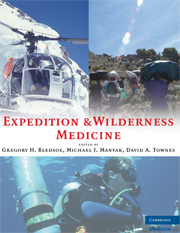Book contents
- Frontmatter
- Contents
- Contributors
- Foreword
- Preface
- Acknowledgments
- PART I EXPEDITION PLANNING
- PART II EXPEDITIONS IN UNIQUE ENVIRONMENTS
- 13 Tactical and Protective Medicine
- 14 Hostile Geopolitical Environments
- 15 Aerospace Medicine
- 16 Polar Medicine
- 17 Tropical Medicine for Expeditions
- 18 Subterranean Medicine
- 19 High-Altitude Medicine
- 20 Medicine at Sea
- 21 Event Medicine
- 22 Telemedicine in Evolution: Implications for Expeditionary Medicine
- 23 Dive Medicine
- PART III ILLNESS AND INJURIES ON EXPEDITIONS
- APPENDIX The Expedition Medical Kit
- Index
22 - Telemedicine in Evolution: Implications for Expeditionary Medicine
from PART II - EXPEDITIONS IN UNIQUE ENVIRONMENTS
Published online by Cambridge University Press: 05 March 2013
- Frontmatter
- Contents
- Contributors
- Foreword
- Preface
- Acknowledgments
- PART I EXPEDITION PLANNING
- PART II EXPEDITIONS IN UNIQUE ENVIRONMENTS
- 13 Tactical and Protective Medicine
- 14 Hostile Geopolitical Environments
- 15 Aerospace Medicine
- 16 Polar Medicine
- 17 Tropical Medicine for Expeditions
- 18 Subterranean Medicine
- 19 High-Altitude Medicine
- 20 Medicine at Sea
- 21 Event Medicine
- 22 Telemedicine in Evolution: Implications for Expeditionary Medicine
- 23 Dive Medicine
- PART III ILLNESS AND INJURIES ON EXPEDITIONS
- APPENDIX The Expedition Medical Kit
- Index
Summary
INTRODUCTION
According to the Travel Industry Association of America, 31 million adults have taken a rigorous adventure trip in the past 5 years. Even though the vast majority of these travelers return unscathed from these trips, the climatic and environmental conditions coupled with the exertive nature of an expedition pose a serious risk of injury and/or illness. Because many of these adventures take place in both remote and rugged locations, without the presence of a trained medical specialist, telemedicine can offer an adjunctive bridge to treatment.
In its simplest form, telemedicine is a basic telephone call. This is a key point to remember, as much of the sophisticated technological infrastructure commonly associated with telemedicine will generally not be available to an expedition. Telemedicine is commonly defined as the use of electronic communication and information technologies to provide or support clinical care at a distance (Department of Commerce, 1997).
A broader concept is that of telehealth, which is defined as the use of electronic information and telecommunications technologies to support long-distance clinical health care, patient and professional healthrelated education, public health and health administration (Department of Health and Human Services, 2001).
This chapter is designed to provide an overview of telemedicine applications adaptable to the needs of expedition medicine. The complex legal issues associated with telemedicine will not be addressed due to the disparate geography of expeditionary medicine and the difficulty in interpreting numerous international laws regarding this subject.
- Type
- Chapter
- Information
- Expedition and Wilderness Medicine , pp. 306 - 322Publisher: Cambridge University PressPrint publication year: 2008



